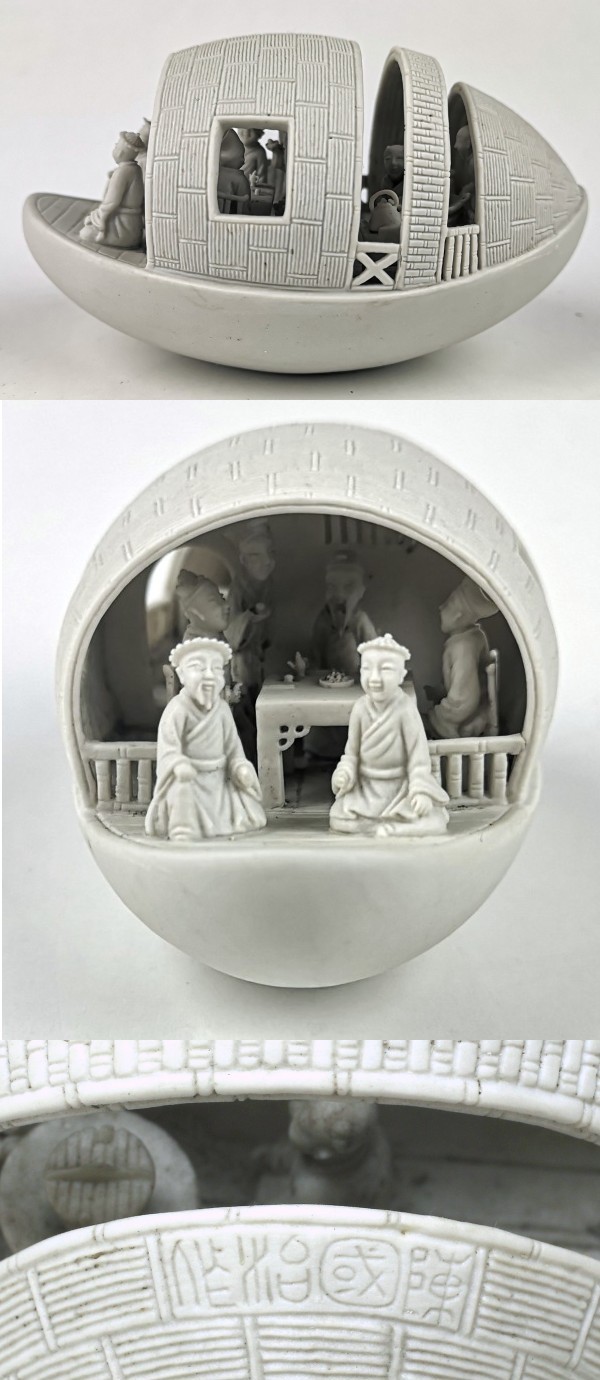
Miniature boat carved in the shape and of the size of a duck's egg, signed by incised four characters Chen Guozhi Zao on the aft part of the roof. Legth: 9,3 cm, 3,7 inch.
The motif could be a playful reference to the Ode to the Red Cliff, from when Su Shi and friends' visited the Red Nose Cliff (赤鼻磯). Based on the looks of the head gear Su Shi himself could be portrayed sitting on the left side of the table. Further in, Cao Guojiu, one of the Eight Daoist Immortals, might be seated at head of the table.
JE Nilsson Coll., 2023
Chen Guozhi was together with Wang Bingrong and Li Yucheng one of the most famous of the about thirty independent ceramicists of the nineteenth century who began to emerge from the traditionally anonymous production of ceramics at Jingdezhen by signing their names, developing distinctive styles and acquiring fame.
Chen Guozhi, a native of Qimen, Anhui Province, was renowned for his ability to carve designs on porcelain with the intricacy and elegance of those found on paintings. He was active during the Daoguang (1821-50) and Xianfeng reigns (1851-1861) and may have worked for the imperial court, evident by the appearance of the (Daoguang 1821-51) reign mark and his name combined on at least one of his pieces.
Although Chen was an accomplished artist of the period, little was mentioned about his career in 19th century literary sources. However, one account appears in Richard John Lynn's 1991 translation of Zhao Zhiqian's (1829-1884) book on snuff and snuff bottles Yonglu Xianjie dating to ca. 1860.
In this account, the unique quality of Chen’s workmanship was described as similar to ‘carved porcelain bottles with the technique of a painter... just as they might appear in an album of paintings done by the Song-era Painting Academy... although there are others who try to imitate his work, no one ever manages to match it.'
The paragraph (page 20) in its entirety is worth quoting
There were a certain Chen Guozhi, a native of Qimen who carved porcelain bottles with the technique of painter (buafa), so pieces by him are absolutely unique in the whole world. I once saw a bottle of his on which he had carved five bats flying up and down and fluttering about, just as they might appear in an album of paintings done by the Song-era Painting Academy. Later he came to grief because he had gone out of his way to scold some thieves. Works by his hand are now almost all scattered and lost, and although there are others who try to imitate his work, no one ever managed to match it.
In Elegance in Relief Tony Miller and Humphrey Hui points out that in several signatures Chen describes himself as a native of nearby Xianyuan rather than Qimen, in Anhui. A gifted painter on porcelain as well as carver, he adopted the studio name Pingzhai. While his earlier work, for example meticulously detailed landscapes, was inspired by the painting style of the Song, later pieces are more innovative and display both complete mastery of the medium and great confidence of expression. Often cartoon-like in their simplicity they are characterized by fluid graze and a hint of humor.
The earliest piece both signed and dated by Chen is a table screen marked first week of the spring of the jichou year (1829) by which time he clearly had made a name for himself. The latest dated piece found so far (2006) is a brush pot dated with a cyclical mark equivalent to 1858. He died not long after, during the lawless period of the Taiping rebellion 1850 to 1864.
Another account by Jin Wuxiang, author of Suxiang Suibi published in the Guangxu period, Jin Wuxiang records that "During the Daoguang reign, there were a man of the town (Jingdezhen) called Chen Guozhi, who painted in color and carved porcelain" and stated that value of Chen's work as "every piece being valued at ten pieces of gold. A Magistrate named Jiang Juting presented him with a calligraphy couplet in praise, reading 'Earth and clay turned to gold and jade; a man in plain cloth becomes of royal rank;'
Literature: H.Moss, V.Graham, and K.B.Tsang, A Treasury of Chinese Snuff Bottles. The Mary and George Bloch Collection. Vol.6. Part 3. Arts of the Fire, Hong Kong, 2008, pp. 759-762.
Richard John Lynn's 1991 translation of Zhao Zhiqian's (1829-1884) book on snuff and snuff bottles Yonglu Xianjie dating to ca. 1860. Page 20.
In Elegance in Relief, Carved porcelain from Jingdezhen of the 19th to Early 20th Centuries by Tony Miller and Humphrey Hui, Hong Kong 2006, Chen Guozhi are illustrated in the following entries and plates:
2 Brush pot w The Eight Immortals, commissioned and dated 1847
4 Brush pot w buffalo boy (Daoguang 1821-51)
13 Brush pot (Tongzhi to Guangxu) (1862-1908), incised signature
15 Brush pot (Daoguang 1821-51), four character seal
17 Brush pot (Daoguang 1821-51), eight character relief seal Daoguang - Chen Guozhi
22 Brush pot w landscape and pavilion (Daoguang to Xianfeng 1821-1860), four character relief seal
41 Brush pot w crane and pine (Guangxu 1875-1908), incised signature
55 Vase w prunus (Daoguang to Xianfeng 1821-1860), four character slipped relief seal
56 Vase w landscape scenes (Daoguang to Xianfeng 1821-1860), four character relief seal
71 Dragon boat w the Eight Immortals (Guangxu 1875-1908), three character mark in double rectangular border
72 Pavilion w the Eighteen Scholars (Guangxu 1875-1908), three character mark in double rectangular border
96 Snuff bottle w buffalo boy (Daoguang to Tongzhi 1821-1874) three character slipped relief seal
103 Seal vermilion box w birds i tree (Daoguang 1821-51), four character raised square seal
167 Plaque w flowers, modern (1960-80)
A